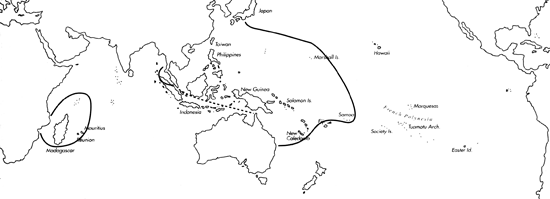Range: Pacific Ocean: Japan to Marshall Is., Samoa, Papua New Guinea, Solomon Is., Queensland, and New Caledonia; Indian Ocean: W. Thailand, Seychelles, Madagascar, Mozambique, and Mascarenes.
Description: Medium-sized to large, moderately solid to heavy; typical form to moderately large and solid, form magister (Pl. 61, Fig. 12) larger than other forms. Last whorl conoid-cylindrical to conical or ventricosely conical in typical form, conical in form magister, and conical or ventricosely conical to broadly conical or broadly and ventricosely conical in form thailandis (Pl. 61, Figs. 15-17); outline convex at adapical fourth to third, straight below. Shoulder rounded to subangulate, to angulate in form thailandis. Spire of low to moderate height, usually low in form magister; outline straight in typical form, concave in other forms. Larval shell of about 3 whorls, maximum diameter about 0.8 mm. First 1-2 postnuclear whorls weakly tuberculate. Teleoconch sutural ramps slightly concave to convex, with 1-2 spiral grooves in earliest whorls increasing to numerous weak spiral striae in following whorls. Last whorl with closely spaced fine spiral ribs basally.
| Shell Morphometry | ||
|---|---|---|
| L | - | |
| (-typical form 40-82 mm; -form thailandis 50-84 mm; -formmagister 70-110 mm) | ||
| RW | - | |
| (-typical form 0.15-0.45 g/mm, L 40-64 mm; -form thailandis 0.44-1.12 g/mm, L 50-84 mm) | ||
| RD | - | |
| (-typical form 0.51-0.64; -form thailandis 0.56-0.72; -formmagister 0.55-0.64) | ||
| PMD | 0.81-0.91 | |
| RSH | 0.07-0.12 | |
Colour yellowish to orangish or reddish brown, with sparse to numerous white tents and flecks on last whorl and teleoconch spire; white markings evenly distributed or concentrated in spiral bands, sometimes fused into large blotches and flames. Last whorl with very fine, variably spaced, prominent to obsolete, darker brown spiral lines, sometimes articulated with very small white markings. Base dark violet-brown. Apex pinkish white to pinkish orange. Aperture white.
Periostracum yellow-grey, thin, translucent, smooth.
Dorsum of foot white, heavily mottled with brown or reddish brown, lightly mottled medially; anterior part with 2 lateral black blotches distally. Sole of foot more uniform brown. Rostrum tan to orange-brown. Tentacles white, mottled with brown; tip solid brown. Siphon white, mottled with brown, sparsely mottled centrally; tip grading to solid orange-brown, demarcated from the central zone by a dark brown to black ring (Richards, pers. comm., 1988; Pearson, unpubl. observ.). Form magister differs in having heavier brown mottling of the foot; entire dorsum appears brown, sparsely mottled with white. Rostrum with dark brown longitudinal and transverse lines, sole of foot with dark brown longitudinal lines. Tentacles and siphon match those of typical form in colour pattern (Doiteau, 1981; Estival, unpubl. observ.).
In form thailandis, radular teeth slender, with 2 opposed adapical barbs; long serration extending from the end of the second barb 2/3 of the length down the shaft, ending in a cusp (Rolán, 1993).
Habitat and Habits: In 1-80 m; on coral reef, from lagoon pinnacles to the outer slope of the reef, in sand, muddy sand and coral rubble. Form thailandis reported from 20-40 m, form magister from about 20 m (da Motta, 1978; Doiteau, 1981; Bayer, pers. comm., 1993).
Discussion: The typical form of C. crocatus was misidentified as C. colubrinus (Walls, [1979]); the latter actually is a synonym of C. pennaceus (Kohn, 1981; Tucker, 1984a; Coomans et al., 1985a); for comparison, see the Discussion C. pennaceus. C. lamberti is similar to C. crocatus form magister; for the distinctions, see the Discussion of the former species. The conchological differences between typical C. crocatus and C. thailandis do not justify separation at the species level. Subadult shells of the latter may nearly match typical C. crocatus in shape, and intermediate specimens are known from New Britain, Solomon Is., Réunion, Seychelles (Pl. 61, Fig. 13), Madagascar, and St. Brandon (Pl. 61, Fig. 14). We therefore consider C. thailandis to represent the local form of C. crocatus from the W. Thailand area. Specimens described as C. magister correspond closely to typical C. crocatus in the colour pattern of the animal and to form thailandis in shell characters. We consider C. magister to represent a large local form of C. crocatus from the Nouméa area, New Caledonia.

C. crocatus range map
This section contains verbatim reproductions of the accounts of 316 species of Conus from the Indo-Pacific region, from Manual of the Living Conidae, by Röckel, Korn and Kohn (1995). They are reproduced with the kind permission of the present publisher, Conchbooks.
All plates and figures referred to in the text are also in Röckel, Korn & Kohn, 1995. Manual of the Living Conidae Vol. 1: Indo-Pacific Region.
The range maps have been modified so that each species account has it own map, rather than one map that showed the ranges of several species in the original work. This was necessary because each species account is on a separate page on the website and not confined to the order of accounts in the book.